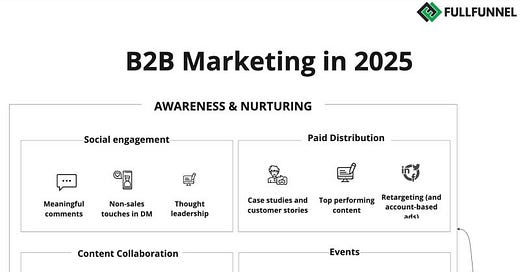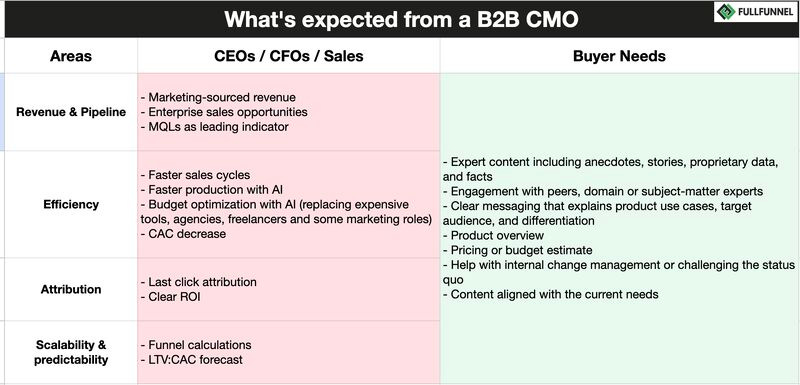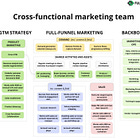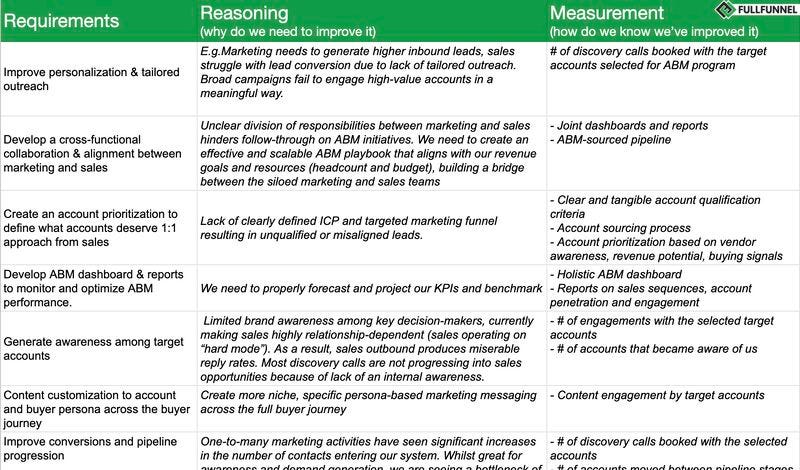🕵🏻♂️ B2B marketing in 2025
My observations about the rotten reality of B2B marketing in 2025, and how to move forward.
CEO to a new VP of Marketing: "We expect you to generate marketing-sourced revenue and leads."Product: $150k+ deal size, 12-16 month sales cycle.
6 months later: "You're laid off. We don't see enough marketing-sourced leads and revenue."
Sounds familiar?
Stay tuned!
In this newsletter we'll share:
The 2025 B2B CMO dilemma
How AI makes things better and worse at the same time
How to move forward in a new B2B marketing matrix and my predictions
Drive pipeline THIS quarter with full-funnel ABM programs.
If any of these challenges sound familiar:
You are aligned in theory with sales but don’t do anything in practice aside from receiving wish lists from sales and sharing with them your marketing plan. In reality, you work in silos and miss the revenue targets and are being pressured by your executives.
You understand that your marketing and sales playbook is broken (mqls, gated content) but despite many attempts you don’t know how to fix it
Your outbound, paid ads and organic pipeline drastically decreased while CAC increased mostly because most of your market is problem unaware and not buying.
You lack brand awareness among target accounts and sales can’t get even a reply.
You clearly see that you're already behind your revenue targets
We can help.
We'll develop a custom full-funnel ABM strategy aligned with your resources, budget and stack and execute it together to drive results THIS quarter.
The 2025 B2B CMO dilemma
2025 is a really tough time for B2B CMOs.
They are caught between two fires: CEO, CFO, Sales on one side and Buyer Needs on another.
Executives challenge CMOs to drive pipeline and revenue but don't give them a chance to work on what is ACTUALLY creating the pipeline in the long term (and what B2B buyers value): thought leadership, partner and influencer marketing, customer and brand events.
These activities don't drive immediate $ and are difficult to attribute. They require revamp of CRM or buying end-to-end analytics. It requires additional budget that is often blocked by CFOs.
Earlier this year I chatted with several VPs of marketing who were hired to build marketing from scratch in sales-led organizations but were laid off because of lack of "marketing-sourced revenue".
Here is the rotten reality they have faced.
1. LACK OF CROSS-FUNCTIONAL COLLABORATION WITH SALES.
CMOs are supposed to generate revenue faster than sales do and ALONE. Out of thin air. They wish to work with sales, but sales teams are focused on short-term goals.
Sales leaders don't provide dedicated resources for joint efforts with marketing and expect marketing to generate enterprise sales opportunities for them.
The only type of collaboration that exists is throwing sales wish lists to marketing and getting back a list of MQLs.
But pause for a second and ask yourself:
If marketing could drive enterprise pipeline alone, wouldn't marketing teams be larger than sales teams?
Learn more about cross-functional collaboration here:
2. QUANTITY > QUALITY.
Executives push for more activities to fill the pipeline, leaving no time for CMOs and marketing teams to analyze the results of current activities, make sense of captured signals and intent.
They put marketing leaders into a “lead generation hamster wheel” and ask to run faster.
The problem?
Brand awareness is not there, so sales can't even get a reply to their outreach.
Outbound, paid ads, and organic pipeline drastically decreased while CAC increased, mostly because most of your market is problem-unaware and not buying.
And if marketing dares to try something new, every marketing activity they present MUST demonstrate clear ROI. No attribution - no approval.
3.DO MORE WITH LESS (AKA RUNNING FASTER IN THE HAMSTER WHEEL).
Shopify's CEO Tobi Lütke recently sent a memo to his team about using AI. Before asking for any new hires or more resources, Shopify employees now need to prove that AI can't do the job first.
It became a golden standard for many B2B tech companies.
Stakeholders regularly share LinkedIn posts about new AI tools that automate and influence the entire buyer journey on autopilot in the Teams or Slack, and ask marketing to implement them. Not ask, require!
Just check the post from Allsion below.
While budgets and teams are cut.
The problem, though, was laid in the previous steps - CMOs and their teams SIMPLY don't have time to incorporate AI into their workflows. Most of them even don’t have robust marketing playbooks and workflows, and run “random acts of marketing” to keep up with volume and protect their job.
The Garbage In - Garbage Out problem is real.
Everybody can create content, personalized outbound emails, or ads in ChatGPT. But this is the exact reason why SEO is slowly dying, and LinkedIn newsfeed is full of the same content.
What executives forget is that B2B buyers have access to the same tools as their marketing and sales teams.
If your content is "uniquely created" by ChatGPT, you are perceived as a commodity.
B2B buyers want to see real expertise, anecdotes, unique facts and data, and real humans behind the brand. Content is not a traffic channel anymore; it's a brand and demand generation channel.
GET ACCESS TO A NEW FULL-FUNNEL ABM 2.0 COURSE
What's included with the course access:
12 modules covering step-by-step ABM strategy development: goal decomposition, ICP, account list building, ABM team, warm-up and activation playbooks, reporting, scaling ABM and building a cohesive ABM & demand gen function.
Short explanation videos and "how to" examples. We believe it's better one time to see a practical example then listen to the theory hundreds of times.
5 orchestrated and ready-to-use ABM playbooks and a detailed explanation
Report dashboard for 4 types of ABM programs: new revenue, pipeline acceleration, expansion and churn prevention
Live case studies and examples of the campaigns we implemented with the clients of Fullfunnel.io in the past few years
17 templates to simplify your ABM strategy launch: ICP, revenue analysis, intent data tracking, account warm-up cadence, customer research, account scoring and prioritization, ABM budget planning and forecasting, account planning, reports, personalized offers, and many more.
Planning & Presenting a Pilot ABM Program to Execs and Sales Framework
Minimal viable stack recommendation and guidelines on how to use it to avoid ramping up budget and being pressured to show ROI for the purchased $50k software
WHO SHOULD TAKE THE FIRST STEP?
The old quote says:
A fish rots from the head down.
Often, bad leadership is a real problem and is the root reason for many GTM problems. Some executives get it, but try to solve the GTM problem in an easy way:
“Hey, marketing and sales. From today you should work together. Here is your $50M annual revenue goal”.
Just giving marketing and sales a shared revenue goal and telling them to work together never works.
The only way to go from spreadsheet revenue projections to real revenue is by:
Giving marketing and CMOs a strategic role
Fixing GTM fundamentals
Enabling cross-functional collaboration
Allowing CMOs to think and act strategically
Giving time and money to upskill marketing team and increase efficiency
Below is a detailed breakdown of short-term and long-term strategic changes executives must make TOGETHER with their GTM team: marketing, sales, product and client success.
Short-term changes (aka first steps).
1. UNDERSTAND THE CURRENT CHALLENGES.
Your team might be under-resourced and stretched in multiple directions. Sales motions and incentives are completely misaligned with the buyer journey.
Target accounts are not progressing, not because you have a bad sequence in Hubspot with "personalization at scale", but because the content and CTAs are not aligned with their interests and needs.
2. UNDERSTAND THE IMPACT.
It's easy not to see the forest for the trees. You need to understand which challenges impact your GTM and low pipeline creation. Then, prioritize which ones are vital to work on.
3. CREATE REQUIREMENTS AND ENABLE YOUR TEAMS.
Saying "work together" is easy. Defining what "working together" actually looks like is hard. Defining "what is good" is even harder.
You need to:
define clear expectations
enable teams to experiment
give them the time to learn and adopt new processes
define the change management driver who can handle the bottlenecks and resistance
4. DEFINE MEASUREMENT CRITERIA.
How do you know you've solved a specific challenge or refined a specific process? Make clear definitions and metrics the team can report on.
You can only create pressure about revenue and pipeline progression when you have enabled the team with the resources and workflows. Most companies don't often realize that the biggest bottleneck is their culture: silos, endless approvals and discussions, wrong incentives, etc.
You can hire the best talent, but this talent won't be able to move the needle in this environment.
It's not "their goal to figure it out". It's an organizational goal to understand how to achieve the revenue goals and establish long-term growth.
BECOME A FULL-FUNNEL B2B MARKETER
Full-Funnel Academy is a comprehensive B2B marketing training and Slack community for B2B marketers who care about revenue and want to move the needle.
Academy includes:
All our B2B marketing courses including ABM playbook, Demand Gen Playbook, LinkedIn Allbound marketing playbook and 11 more courses that aren't available publicly + all upcoming courses.
Private Slack community to answer all your questions
Personalized learning plan. If you are not sure what skills you’d develop in the first place and how to get maximum from the program, we can create a personalized learning plan accordingly to the time you can dedicate to education.
Behind the scenes sessions. See what’s working and what doesn’t work and why on the “behind the scenes” sessions where we review the campaigns we are running for our clients and us.
30% discount for live events and bootcamps
Learn more and join the academy here.
Long-term strategic changes.
My bet:
Only B2B teams that can build an audience and community, stand out, and create cross-functional revenue alignment will continue to grow in the long term.
Why?
In the AI era, you are one click away from being copied. Garage startups make a clone of your product and spam all of your TAM in one month.
If you don't have a brand, if you don't have a community, - you're doomed. Startups die fast.
Corporates see decreasing revenue slower, but Nokia also thought they'd be market leader forever.
Today with AI, everybody can copy the product and create a cheaper alternative. Everybody can put in ChatGPT viral posts from LinkedIn and ask it to create a similar content, but for your audience.
But what nobody can copy is your:
Point of view and reputation
Relationship with the target accounts and your community
If you sell a mass commodity product, you can still focus on the mythological "3% in-market accounts." But what's your key advantage?
In the best case scenario, you'll compete on speed and price. How sustainable is this? Only to survive a bit.
Here are 5 essential long-term strategic changes you need to make.
1. FIX THE MARKETING AND SALES SILOS.
Turn them into a cross-functional team with unified GTM and goals. Align on revenue metrics, ICP criteria, buyer journey playbooks, and personalization activities.
2. INVEST IN CUSTOMER RESEARCH.
This is non-negotiable to understand what topics matter to your buyers, what channels they use, what triggers their buying process, and how their journey unfolds.
3. QUALITY > QUANTITY.
Invest in ICP-first activities aligned with the level of demand and intent: unique research, expert content, educational events, and content that addresses actual buyer questions.
4. CO-CREATE WITH PEERS AND AMPLIFICATION AUDIENCES.
To get into "private" channels, partner with communities, brands targeting the same audience, micro thought-leaders, and customers who can share authentic experiences.
5. BUILD A FULL-FUNNEL MARKETING MODEL ALIGNED WITH THE BUYER JOURNEY.
Create awareness in the right channels, define engagement thresholds, map buying committees, enable your champions with personalized content, and invest in customer experience.
To maintain these changes, here are the key rules:
Revenue and sales pipeline velocity are the north stars for both marketing and sales.
Building consistent, long-term marketing programs that compound over time and influence the entire buyer journey.
Measuring marketing and sales impact through a blended attribution model—self-attribution, digital analytics, and customer interviews to see a full picture.
ICP-led targeting: full-funnel approach to nurture buyers across the buyer journey
Unified teams: Sales, Marketing, CS, and Ops align on revenue goals, pipeline and joint playbooks.
Balanced budget allocation across brand, ABM, buyer enablement, and customer success & expansion.
Rely on marketing intel, customer analysis and historical data to create GTM strategy
Work with us to develop a successful ABM motion.
Our approach enables your team to:
Holistically create brand awareness among key buyer personas of strategic accounts to create a future pipeline.
Achieve revenue alignment between marketing and sales and set up cross-functional collaboration with clear responsibilities, KPIs, and accountability.
Create an account prioritization criteria to define what accounts deserve a 1:1 approach from sales based on relationship, engagement, and buying signals.
Create joint pipeline progression and acceleration playbooks to increase the conversion of engaged contacts and accounts into discovery calls and sales opportunities.
Incorporate ABM in your GTM to make an evolution and increase the efficiency of your existing marketing and sales mix.
Leverage signals, engagement, and intent data, account insights, and research to improve personalization and efficiency of sales outreach.
Customize content to influence the entire buyer journey with industry-specific, account-specific, and buyer persona-specific content.
Create strong documentation to go from random acts of marketing to predictable enterprise pipeline generation.
Creating visibility about ABM progress and results with holistic program and activity dashboards.
My predictions.
At the end of the fiscal year, the AI euphoria will go down. B2B companies will look at P&L, missed revenue targets and realize that the fundamental GTM challenges I've described didn't disappear.
They will have two choices:
a) Take the red pill, accept the challenges and start fixing them to enable long-term growth.
b) Take the blue pill, replace marketing and sales leaders, and buy new AI tools to outrun their competitors.
What's happening right now is brilliantly described by one of my favorite quotes:
Every morning in Africa, a gazelle wakes up, it knows it must outrun the fastest lion or it will be killed. Every morning in Africa, a lion wakes up. It knows it must run faster than the slowest gazelle, or it will starve. It doesn't matter whether you're the lion or a gazelle - when the sun comes up, you'd better be running.
It is the middle of 2025, and it's a perfect time to pause and ask:
Are we building a strong brand and community as a cross-functional revenue unit, or are we just trying to run faster than our competitors offering the same?
*If you enjoyed the post, please, share it with a fellow GTM leader.
Listen to Full-Funnel Live - ABM to professional associations [Live Case Study].
*If you want to attend the next live episode, sign up here to receive an invite. Usually, we host them every Wednesday at 4 pm CET (Central Europe) - 11 am ET (Eastern Time).
In this episode of Fullfunnel Live, we are sharing a live ABM case study of our client, BenchPrep, presenting ABM to professional associations playbook.
Tune in to learn:
What can you expect from the pilot program: live results
The key playbooks we've executed, what worked and what didn't
The main mistakes B2B teams make when trying to launch an ABM program?
How to get buy-in from sales and leadership for ABM
Subscribe to the Full-Funnel podcast:













Great article Andrei, thanks! The question remains how to handle the CEO’s short-term pain.
CEO themselves are under pressure from investors and stakeholders to prove pipeline development and hit revenue quotas every quarter.
Any advice Andrei, on how to address it? And get them onboard for ABM.
Btw, love the use of sayings throughout! And the practical solutions shared to the CMO dilemmas/B2B org challenges. Realise I went all shakes-fists-at-sky earlier.